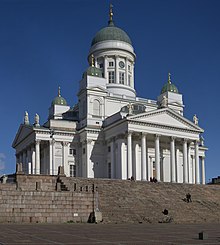Helsinki Cathedral
The Helsinki Cathedral ( finn. Helsingin tuomiokirkko or Suurkirkko , schw. Helsingfors domkyrka ) is a Protestant church in the Finnish capital Helsinki and the cathedral of the Lutheran Diocese of Helsinki . The church, designed by Carl Ludwig Engel , is located on Senate Square in the immediate center of Helsinki and is the city's most famous landmark. It is visited by 350,000 people annually.
history
The cathedral is part of the classicistic center of Helsinki, built between 1820 and 1850 . Carl Ludwig Engel delivered the first plans for the cathedral as early as 1819. Construction began in 1830 and was completed in 1852. At first it was named in honor of the Russian Tsar Nicholas I after his patron saint , St. Nicholas , named.
After Finland became independent in 1917, the name was changed to Suurkirkko ("Great Church"). After the establishment of the Helsinki diocese in 1959, the church became Helsinki Cathedral .
The boys' choir Cantores Minores at Helsinki Cathedral was founded in 1952.
architecture
The classical cathedral is a cross-domed church with a floor plan in the form of a Greek cross . Engel chose this shape because the cathedral could be seen from all sides. This makes it clear that Engel was inspired by Orthodox architecture in Russia , since the St. Isaac's Cathedral was just being built by Auguste de Montferrand in Saint Petersburg , Engel orientated himself on it. The central dome and the Corinthian columns with the gable triangles at the ends of the cross dominate the external impression. The cathedral stands on a stone foundation, on the side of which facing the Senate Square was originally a guard house. This was replaced by a monumental staircase in 1839 against Engels' will.
After Carl Ludwig Engel's death in 1840, changes were made to the church under his successor Ernst Bernhard Lohrmann (1803–1870). Lohrmann added the four small corner towers, statues of the twelve apostles and two pavilions on the sides of the stairs to the cathedral .
The interior of the cathedral is extremely simple and kept entirely in white. The altar is on the east side and the main entrance is on the west side facing Unioninkatu Street . The only decorations in the church are statues of the reformers Martin Luther , Philipp Melanchthon and Mikael Agricola in the corners of the church. In the fourth corner is a round pulpit designed by Engel with a golden canopy.
Furnishing
The organ was built in 1967 by Marcussen & Søn . The organ case comes from a predecessor instrument made by the organ builders Lohrmann and Walcker in 1847. The instrument has 57 stops on four manuals and a pedal . The game actions are mechanical, the stop actions are electric.
|
|
|
|
|
||||||||||||||||||||||||||||||||||||||||||||||||||||||||||||||||||||||||||||||||||||||||||||||||||||||||||||||||||||||||||||||||
- Coupling : I / II, III / II, IV / II; IV / III, I / P, II / P, III / P; IV / P
Individual evidence
Web links
Coordinates: 60 ° 10 ′ 13 ″ N , 24 ° 57 ′ 8 ″ E







